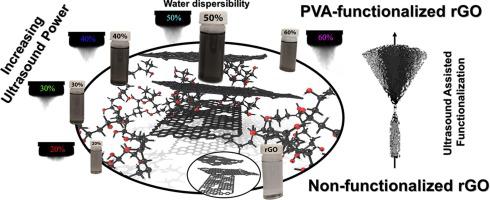Ultrasonics Sonochemistry ( IF 8.7 ) Pub Date : 2022-10-26 , DOI: 10.1016/j.ultsonch.2022.106212 Aleš Ručigaj 1 , Justin G Connell 2 , Matevž Dular 3 , Boštjan Genorio 1

|
Graphene is a valuable and useful nanomaterial due to its exceptionally high tensile strength, electrical conductivity and transparency, as well as the ability to tune its materials properties via functionalization. One of the most important features needed to integrate functionalized graphene into products via scalable processing is the effectiveness of graphene dispersion in aqueous and organic solvents. In this study, we aimed to achieve the functionalization of reduced graphene oxide (rGO) by sonication in a one-step process using polyvinyl alcohol (PVA) as a model molecule to be bound to the rGO surface. We investigated the influence of the sonication energy on the efficacy of rGO functionalization. The correlation between the performance of the high-intensity ultrasonic horn and the synthesis of the PVA functionalized rGO was thoroughly investigated by TGA coupled with MS, and IR, Raman, XPS, Laser diffraction, and SEM analysis. The results show that the most soluble PVA-functionalized rGO is achieved at 50% of the ultrasonic horn amplitude. Analysis of cavitation dynamics revealed that in the near vicinity of the horn it is most aggressive at the highest amplitude (60%). This causes rGO flakes to break into smaller domains, which negatively affects the functionalization process. On the other hand, the maximum of the pressure pulsations far away from the horn is reached at 40% amplitude, as the pressure oscillations are attenuated significantly in the 2-phase flow region at higher amplitudes. These observations corelate well with the measured degree of functionalization, where the optimum functionalized rGO dispersion is reached at 50% horn amplitude, and generally imply that cavitation intensity must be carefully adjusted to achieve optimal rGO functionalization.
中文翻译:

超声空化强度对还原氧化石墨烯功能化的影响
石墨烯是一种有价值且有用的纳米材料,因为它具有极高的拉伸强度、导电性和透明度,以及通过功能化调整其材料特性的能力。通过可扩展加工将功能化石墨烯集成到产品中所需的最重要特征之一是石墨烯分散在水性和有机溶剂中的有效性。在这项研究中,我们旨在使用聚乙烯醇 (PVA) 作为模型分子结合到 rGO 表面,通过一步法超声处理来实现还原氧化石墨烯 (rGO) 的功能化。我们研究了超声处理能量对 rGO 功能化功效的影响。高强度超声变幅杆的性能与 PVA 功能化 rGO 的合成之间的相关性通过 TGA 与 MS、IR、拉曼、XPS、激光衍射和 SEM 分析进行了深入研究。结果表明,最可溶的 PVA 功能化 rGO 是在 50% 的超声波喇叭振幅下实现的。空化动力学分析表明,在喇叭附近,它在最高振幅 (60%) 时最具侵略性。这会导致 rGO 薄片破碎成更小的区域,从而对功能化过程产生负面影响。另一方面,远离喇叭的压力脉动最大值达到 40% 的振幅,因为压力振荡在两相流区域中以较高的振幅显着衰减。











































 京公网安备 11010802027423号
京公网安备 11010802027423号